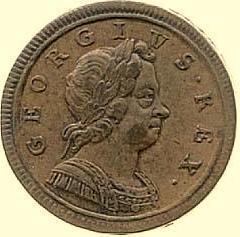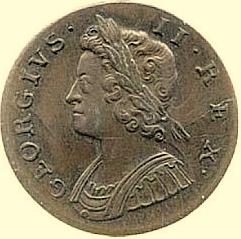1714
DEATH OF ANNE. The death of Queen Anne and the accession of George I.

Queen Anne 5 Guineas.

George I Halfpenny.
1716
10th April –
CATHOLICS CONVICTED.
“William Knaggs, Seniorr, Skelton; William Knaggs Juniorr, Skelton; John Knaggs, Skelton.
These persons before named were convicted as Popish recusants att the generall Quarter Sessions of the Peace holden at Thirske the tenth day of April in the second year of the reigne of his Soveraigne Lord King George in pursuance of an Act of Parliament passed in the first year of his Majestie’s reigne intitled an Act for the further security of his Majestie’s Person and Government and the Succession of the Crown in the heirs of the late Princess Sophia being Protestants and for extinguising the hopes of the pretended Prince of Wales and his open and secrett abettors.
Roman Catholics had been seen as a security threat since Elizabethan times and were subject to penalties.
The first Jacobite Rebellion of 1715 had been supported not just by Scots, but some Catholics of Northern England and their small force had reached as far as Preston before being dispersed.
Shortly after this William Knaggs is recorded again in the Register of Papist Estates in which he is described as owning land in Danby and Skelton, with a mortgage on property in Skelton of £60. His Wife, Isabel and son John are named as his heirs.
1718
FORTUNE DONATED TO SKELTON CHURCH.
£425 was given to Skelton Church to augment its income by the purchase of Sadler Hills estate, which was land between Boosbeck and Margrove Park.
The donors were –
£100 from Mrs Elizabeth Trotter, widow of John Trotter of Skelton Castle.
£20 from Geoffrey Lawson.£20 from the Rev Mr Pemberton.
£20 from Mrs Catherine Bower, widow of William Bower.
£20 from Mr John Trotter, Merchant.
£10 from Alderman Perrot of York.
£10 from Ralph Lowther Esq.
£25 from Rev Thomas Castley, Curate of Skelton with Brotton.
A further £200 was obtained from “Queen Anne’s Bounty”, a National fund that had been set up in 1704 as a Tax on the Church of England Clergy to aid the poorest of them.
9th December –
THE WILL OF GEORGE HUTTON, of Fogga, Skelton. Husbandman.
[Fogga Farm was located in present day North Skelton where the Ironstone Mine was eventually opened in 1872. Called “Old Fogga” on the 1856 Ordnance Survey Map.]
Sons George Hutton, John Hutton.
Daughters Martha Clay, Ellis Brotton, Anne Adam.
Grandchildren George Hutton, Elizabeth Hutton.
Sister Ellis Bolton.
Grandchildren John Hutton, Jane Hutton, Dorothy Hutton & Anne Hutton, John Tooes, Elizabeth Coates.
Wife Ellis Hutton.
Witnesses: Robert Lakeland, Joseph Simpson, Robert Troatles, Frank Duck.


Tombstone in Skelton old Church Yard
1725
THE POOR OF SKELTON.
[Information kindly contributed by Dorothy Harris of Saltburn, N Yorks.]
From a Parish Register dated 1722 to 1775:-
“Given to ye poor of Skelton money ye year 1725, Good Fryday, Easter and Whitsuntide.”
JOHN TIPLADY junior – 7 pence x 2.
REBEKAH SUTHERAN – 7 pence x 2 more 1 shilling.
MARGARET SMITH – 7 pence.
MARY BROTTON – 7 pence x 2.
ELIZABETH DUCK [crossed out]
RALPH POTTER – 7 pence.
MARY MASON – 7 pence x 2.
ALICE BUCK – 7 pence x 2.
ELIZABETH ANN NICKILSON – 6 pence x 2.
MARY CARTER – 9 pence.
ALICE SMITH – 9 pence.
JUDE LAUTON – 4 pence.
ANN SAWER – 9 pence.
ELIZABETH ROGERS – 9 pence.
JOHN COATES – 9 pence.
CAT. LYNAS – 9 pence.
GEORGE COALE – 6 pence x 2.
DOROTHY CARTER – 9 pence x 2.
ELIZABETH RICHARDSON – 9 pence x 2.
JANE WILSON [crossed out]
ROBERT ELLIS – 9 pence x 2.
ROBERT BUCK [crossed out].
ELIZABETH MASON – 9 pence x 2.
——- LAMB – 9 pence.
Given at ye Church – 11 shillings and fourpence and 1 shilling and sixpence.
To Mosam [Moorsholm] poor 3 shillings and twopence.
To WILLIAM FLINTAF – 2 shillings.
To THOMAS PORRET – 6 shillings.
To WILLIAM FLINTAF 1 pound.
Given at ye Church – 1 pound 9 shillings.
To ye poor at Mosam – 1 shilling. To a poor woman – sixpence.
to a poor man – sixpence.
Each Parish had the responsibility to care for its own Poor and Infirm at this time, as demanded by the Elizabethan Poor Law,
Money was collected from land and property owners by the elected Overseers of the Poor and distributed acccording to perceived need.
The above payments would have been in addition and drawn from the various Skelton Charities that had been bequeathed.
1727
CASTLE GAMEKEEPER -Nicholas Lacy appointed Gamekeeper to Lawson Trotter, Esq. for the Manor of Skelton Castle.
DEATH OF GEORGE I – and the accession of George II.

George II Halfpenny.
SKELTON CASTLE ESTATE SOLD
19 years after inheriting Skelton Estate Lawson Trotter, who was unmarried, sold the Estate to the husband of his sister and heiress Catharine.
The new owner was a wealthy Durham merchant named John Hall.
NEW PRIEST George Flower, who remained here for three years.
1730
NEW PRIEST -Thomas Tankred.
1733
BASTARDY ACT.
This ordered that all fathers of illegitimate children shall be committed to gaol until they gave security to indemnify the parish from expense.
See the Parish Rate Book for 1822 on for lists of responsible fathers.
NEW PRIEST at Skelton All Saints Church, from this year until 1760, was Thomas Castley.
DEATH OF JOHN HALL OF SKELTON CASTLE –
6 years after purchasing Skelton Estate.
He was buried in Crossgate Church, Durham and was succeeded by his son, also called John, who was only 15 years of age at the time.
John Hall changed his surname to Hall-Stevenson in 1740 on his marriage to Ann Stevenson and receipt of a large dowry.
He went up to Jesus College, Cambridge University, where he befriended Laurence Sterne, who later achieved fame as the author of ‘Tristram Shandy’ and ‘A Sentimental Journey’.
He left Cambridge without a degree, but well versed in Latin, French and classical literature and like most landed gentry of the day he made the European tour.
On his return to Skelton Stevenson would live the life of the dilettante play-boy of the time.
See page 1756-1773.
Next Page – 1736 TO 1747.
Previous Page – 1693 TO 1713.
Contents Page.